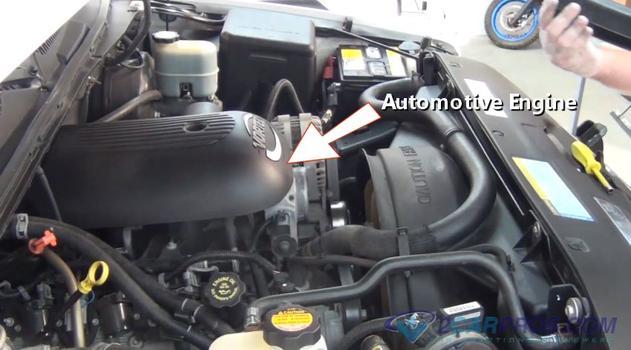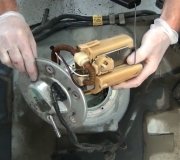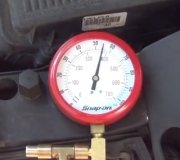Don't worry, it takes a lot to offend me. LOL The STFT1 then is +27.3 and STFT2 is -.8. Ugh. Something is happening. Bank one is adding a lot of fuel to compensate for a lean mixture, and bank 2 really isn't bad.
Since it is specific to bank 1 adding fuel, double check to make sure there isn't an exhaust leak on that side. If the exhaust manifold is leaking, that could be causing it.
As far as the codes you have, the P1000 just indicates that all monitors haven't reset yet. It isn't a concern. The 171 basically confirms the info you sent me.
__________________________
I dug into this further. The diagnostics are very long. I am going to add the first two tests they recommend. Take a look through them and see if there is anything you missed. If there isn't, then I will send you the rest of the diagnostics.
__________________________
H40 DTCS P0171, P0174, P1130, P1131, P1150, P1151, P2195 OR P2197: LEAN SYSTEM DTCS
Note:Do not clear the DTCs or reset the keep alive memory (KAM).
Fuel System and HO2S DTC Reference List:
- Bank 1 = DTC P0171 (lean)
- Bank 2 = DTC P0174 (lean)
- HO2S-11 = DTCs P1130, P1131, and P2195
- HO2S-21 = DTCs P1150, P1151, and P2197
- Access and record the ECT PID from the freeze frame data. The freeze frame data will be used to recreate the concern.
- Retrieve and record the self-test DTCs.
Are any DTCs present other than P0171, P0174, P1130, P1131, P1150, P1151, P2195 or P2197?
Yes
- DISREGARD the current diagnostic trouble code (DTC) at this time. GO to Section 4, Diagnostic Trouble Code (DTC) Charts See: A L L Diagnostic Trouble Codes ( DTC ) > Diagnostic Trouble Code Descriptions > Diagnostic Trouble Code (DTC) Charts and REPAIR the other DTCs.
No
- GO to H41
.
H41 CARRY OUT A VISUAL INSPECTION OF THE INTAKE AIR SYSTEM AND ALL VACUUM HOSES
- Check the intake air system for leaks, obstructions, and damage.
- Inspect the entire length of all the vacuum hoses for:
- proper connections.
- damage or cracks.
- damaged or cracked vacuum tees.
- Verify the integrity of the positive crankcase ventilation (PCV) system.
- Verify the proper PCV valve part number.
Is a concern present?
Yes
- GO to H44
.
No
- GO to H42
.
H42 CHECK FOR THE PRESENCE OF A VACUUM LEAK
Note:Fuel trim values at idle are more sensitive to a vacuum leak. The vacuum leak (unmetered air) represents a larger portion of the total air flow at idle than at part throttle.
Note:The barometric pressure (BARO) PID is not a recommended PID to monitor when diagnosing a vacuum leak. Barometric pressure is calculated during high engine load, when the vacuum leak represents a small portion of the total air flow.
Note:As an example, when calculating the total fuel correction in the following steps, if LONGFT1 = +13% and SHRTFT1 = +23%, the total fuel correction for bank 1 = +36%, also if LONGFT2 = +24% and SHRTFT2 = -3% the total fuel correction for bank 2 = +21%.
Note:If the freeze frame ECT PID is available, stabilize the engine at the temperature recorded by the freeze frame ECT PID. If the freeze frame ECT PID is not available, maintain the engine coolant temperature between 82°C - 101°C (180°F - 215°F) and the intake air temperature less than 46°C (115°F).
- Key on, engine running.
- Access and monitor the ECT or CHT, IAT, LONGFT1, SHRTFT1, LONGFT2 and SHRTFT2 PIDs.
- Allow the engine to stabilize at the temperature necessary to recreate the concern.
- Add and record the LONGFT PID value to the SHRTFT PID value for each bank, for a total fuel correction at idle.
- Increase the engine speed to 2500 rpm for 10 seconds.
- Record the LONGFT1, SHRTFT1, LONGFT2, and SHRTFT2 PID values.
- Add and record the LONGFT PID value to the SHRTFT PID value for each bank, for a total fuel correction at 2500 rpm.
Is the total fuel correction value change, between idle and 2500 rpm, less than 15 percent?
Yes
- No vacuum leak is present.
- GO to H47
.
No
No
- GO to H43
.
H43 LOCATE THE VACUUM LEAK
image
CAUTION: Do not clamp or pinch a hard plastic hose. Use a vacuum cap or equivalent to restrict the hose.
Note:Restricting the EVAP vapor hose while the EVAP emission canister is purging may shift the SHRTFT. Carry out a visual inspection as necessary.
Note:As an example, when monitoring for a decrease in the SHRTFT PIDs in the following steps, if SHRTFT1 is +15%, but when the hose is restricted SHRTFT1 decrease to -7%, the decrease in the SHRTFT PIDs = 22 percent.
- Locate the vacuum tees for the intake air and PCV systems.
- Access and monitor the SHRTFT1 and SHRTFT2 PIDs.
- Restrict the vacuum lines one at a time for 30 seconds. If a vacuum leak is present, the SHRTFT PID values will decrease as the hose is restricted.
Is the decrease in the SHRTFT PIDs greater than 15 percent when one of the vacuum hoses is restricted?
Yes
- GO to H44
.
No
- INSPECT the intake air system for a vacuum leak in the intake manifold or intake gaskets. REPAIR as necessary.
__________________________
Let me know if this helps and what you find.
Joe
SPONSORED LINKS
Was this helpful?
Yes
No
+2
Tuesday, July 7th, 2020 AT 8:37 PM




